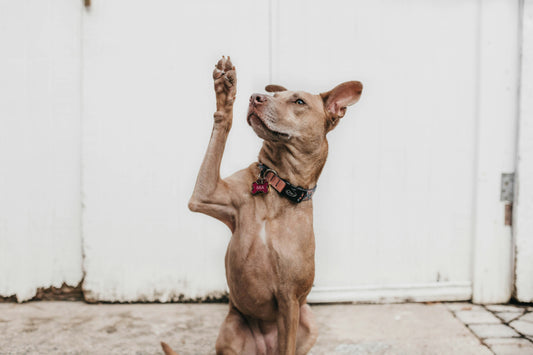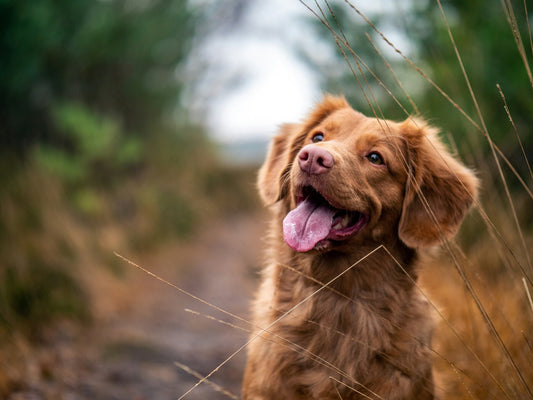How to Deal with Shoulder Pain in Dogs

Shoulder pain is a condition that can significantly affect your dog’s quality of life. The complexity of the shoulder joint, combined with the active nature of most dogs, makes this area particularly susceptible to injuries. Recognizing, understanding, and effectively managing shoulder pain is crucial to ensure your dog can lead a happy, active life.
In this article, we’ll tell you all you need to know about shoulder pain in dogs. From identifying the signs of discomfort to understanding the anatomy of the shoulder joint and exploring the various treatment options available, we’ll break down everything for you.
Understanding Dog Shoulder Pain
Anatomy of the Dog’s Shoulder
The shoulder of a dog is a highly mobile and complex area, comprising the shoulder joint, which is a ball and socket joint similar to that in humans. This joint is formed where the head of the humerus (upper arm bone) fits into the glenoid cavity of the scapula (shoulder blade). Surrounding the shoulder joint are various ligaments, tendons, and muscles that provide support and facilitate a wide range of movement. Key structures include the biceps tendon, which plays a crucial role in stabilizing the front leg during movement, and the soft tissues that protect and connect these bones.
Common Causes of Shoulder Pain
Shoulder pain can arise from a variety of causes, ranging from acute injuries to chronic conditions. Some of the most common causes include:
- Soft Tissue Injuries: Sprains and strains affecting the muscles, ligaments, and tendons around the shoulder joint are prevalent, especially in active and large breed dogs.
- Bicipital Tendinitis: Inflammation of the biceps tendon can lead to significant discomfort and is often a result of repetitive motion or overuse.
- Medial Shoulder Instability (MSI): This condition occurs when the supporting structures of the shoulder joint become weakened or damaged, leading to instability and pain.
- Osteochondritis Dissecans (OCD): A developmental disorder where the cartilage in the joint fails to form properly, leading to joint pain and stiffness.
- Trauma: Accidents or injuries, such as being hit by a car or falling from a height, can cause direct damage to the shoulder joint and surrounding tissues.
Signs and Symptoms
Identifying shoulder pain in your dog can be challenging, as dogs are naturally inclined to mask discomfort. However, there are several signs of a shoulder injury you can look out for:
- Limping or Lameness: One of the most obvious signs of shoulder pain is a change in gait, such as limping or reluctance to put weight on the affected leg.
- Behavioral Changes: A dog experiencing shoulder pain may show less interest in play, appear lethargic, or be reluctant to engage in activities they usually enjoy.
- Swollen Shoulder: In cases of acute injury or inflammation, you may notice swelling around the shoulder area.
- Pain on Touch: Your dog may react when the shoulder area is touched or manipulated, indicating discomfort.
- Altered Posture: Dogs with shoulder pain may hold their leg in an abnormal position or display stiffness when moving.
Understanding the anatomy and common causes of shoulder pain in dogs is the first step in addressing this condition. By recognizing the signs and symptoms early, you can quickly take action to alleviate your dog’s discomfort and prevent further injury.
Diagnosing Shoulder Pain in Dogs
Veterinary Examination
The first step in diagnosing shoulder pain in your dog is a comprehensive veterinary examination. During this exam, your vet will gather a detailed history of your dog’s health, behavior, and the onset of symptoms. They will observe your dog’s gait, looking for signs of limping or reluctance to use the affected limb. A physical examination will follow, where the vet palpates (examines by touch) the shoulder area to assess for pain, swelling, or abnormalities in the structure of the joint.
Veterinarians are trained to look for subtle signs of discomfort and can perform specific tests to evaluate the shoulder joint’s stability and integrity. These may include manipulating the joint to check for signs of medial shoulder instability or soft tissue injury. Your vet will also assess the range of motion and look for any signs of pain or resistance that could indicate an underlying issue.
Advanced Diagnostic Tools
In some cases, a physical examination alone may not provide a definitive diagnosis. This is where advanced diagnostic tools come into play.
- X-rays: Radiographs can help identify changes in the bone structure of the shoulder joint, such as fractures or signs of osteoarthritis. However, X-rays may not always show soft tissue injuries clearly.
- Ultrasound: This imaging technique is excellent for examining soft tissue structures around the shoulder, including the biceps tendon and other tendons and ligaments. It can help identify tears, inflammation, and other abnormalities.
- MRI (Magnetic Resonance Imaging): MRI is one of the most detailed imaging techniques available for diagnosing shoulder pain in dogs. It provides high-resolution images of both the bone and soft tissues, making it invaluable for identifying soft tissue injuries, shoulder instability, and other conditions that may not be visible on X-rays or ultrasound.
- CT Scan: Computed Tomography (CT) scans can also be used to get a more detailed view of the shoulder joint, especially for complex cases where bone and soft tissue evaluation is necessary.
These diagnostic tools are essential for making an accurate diagnosis and formulating an effective treatment plan. Depending on the findings, your vet may recommend a combination of treatments to address both the symptoms and the underlying cause of your dog’s shoulder pain.
Common Shoulder Injuries and Conditions
Bicipital Tendinitis
Bicipital tendinitis is an inflammation of the biceps tendon, a crucial component in the shoulder joint’s mobility and stability. This condition often results from repetitive stress or overuse of the biceps muscle, making it a common ailment in active and large breed dogs. Symptoms include lameness or limping, pain upon palpation, and reluctance to use the affected limb. Treatment typically involves rest, anti-inflammatory medications, and in more severe cases, injections or surgery to relieve tension on the tendon.
Osteochondritis Dissecans (OCD)
Osteochondritis Dissecans is a condition where the cartilage within the joint fails to develop properly, leading to joint pain and stiffness. It’s most commonly seen in young, growing dogs, particularly those of large or giant breeds. Signs of OCD include limping, difficulty in rising, and a decreased range of motion. Treatment options range from conservative management with rest and medication to surgical intervention to remove the damaged cartilage and stimulate new growth.
Medial Shoulder Instability (MSI)
Medial Shoulder Instability is characterized by a loosening or weakening of the ligaments that support the shoulder joint, leading to instability and pain. It can result from acute injury or chronic wear and tear. Symptoms include lameness, pain, and a noticeable decrease in activity levels. Treatment often involves a combination of rest, physiotherapy, and in severe cases, surgical repair of the damaged ligaments to restore stability to the joint.
Supraspinatus Tendinopathy
This condition involves damage or degeneration of the supraspinatus tendon, part of the muscle group that helps stabilize the shoulder joint. It’s often seen in athletic or working dogs and can result from repetitive use or injury. Symptoms include lameness, pain, and sometimes a swollen shoulder. Treatment typically involves rest, anti-inflammatory medication, and rehabilitation exercises. In some cases, therapeutic injections or surgery may be necessary.
Infraspinatus Myopathy
Infraspinatus myopathy is a condition affecting the infraspinatus muscle, leading to pain, stiffness, and lameness in the affected limb. It can occur due to trauma or overuse and is characterized by a hardening of the muscle tissue. Treatment focuses on relieving the symptoms and may include medications, rest, and physical therapy. In chronic cases, surgical intervention may be required to release the contracted muscle and restore function.
Treatment Options for Shoulder Pain in Dogs
Conservative Management
The first line of treatment for shoulder pain often involves conservative management, including:
- Rest and Activity Modification: Limiting activity to prevent further injury and promote healing is crucial. This may involve leash walks only and avoiding stairs and jumping.
- Pain Management: Non-steroidal anti-inflammatory drugs (NSAIDs) are commonly prescribed to reduce pain and inflammation. Always use medications under the guidance of a veterinarian to avoid potential side effects.
- Anti-inflammatory Medication: These can help reduce inflammation and swelling in the shoulder joint, providing relief from pain.
Physical Therapy and Rehabilitation
Rehabilitation plays a vital role in the recovery process, especially for chronic conditions or after surgery. Options include:
- Physiotherapy: Custom exercises can help strengthen the muscles around the shoulder, improve flexibility, and reduce the risk of future injuries.
- Hydrotherapy: Swimming or walking in water can be an excellent low-impact exercise to maintain muscle mass without putting too much strain on the shoulder.
- Laser Therapy: This non-invasive treatment uses light to reduce inflammation and promote healing in the tissues.
Advanced Treatments
For cases that do not respond to conservative management, more advanced treatments may be necessary:
- Surgical Options: Surgery may be required to repair torn ligaments, remove damaged cartilage, or stabilize the shoulder joint.
- Injections: Cortisone injections can provide relief from inflammation, while platelet-rich plasma (PRP) injections can promote healing in damaged tissues.
By understanding the common shoulder injuries and conditions that can affect dogs, as well as the various treatment options available, you can work with your veterinarian to develop a comprehensive care plan that addresses your dog’s specific needs. With the right approach, most dogs can recover from shoulder pain and return to their happy, active selves.
Preventing Shoulder Injuries
Preventing shoulder injuries in dogs, especially in those breeds prone to such issues, is crucial for maintaining their health and well-being. While not all injuries can be prevented, there are several strategies you can employ to minimize the risk:
- Proper Exercise: Ensure your dog gets the right amount of exercise tailored to their breed, age, and health status. Avoid excessive repetitive activities that put undue stress on the shoulder, such as constant fetching or jumping.
- Body Weight Management: Keeping your dog at a healthy weight reduces the strain on their joints and muscles, including the shoulder. Overweight and obese dogs are at a higher risk for developing joint and soft tissue injuries.
- Nutrition: A balanced diet rich in essential nutrients supports overall health and aids in the maintenance of strong bones and joints. Supplements such as omega-3 fatty acids, glucosamine, and chondroitin can also support joint health, but always consult your vet before adding supplements to your dog’s diet.
- Joint Support Supplements: Incorporating a joint support supplement like Bando’s Hip & Joint Care with Hemp Soft Chew Pet Supplements can be beneficial. These supplements are formulated to support joint health and mobility, and the inclusion of hemp may provide additional anti-inflammatory benefits. Always discuss with your vet before starting any new supplement to ensure it’s appropriate for your dog’s specific health needs.
- Regular Veterinary Check-ups: Routine vet visits allow for early detection and management of potential health issues that could contribute to shoulder pain or injuries. Your vet can also provide personalized advice on exercise and nutrition based on your dog’s specific needs.
Schedule a Consultation with Bando’s Vet Experts
If you suspect your dog is suffering from shoulder pain or if you’re looking to prevent joint issues, don’t wait to seek help. Our team of experts can guide you in setting up the right regimen to help your dog stay pain-free. Schedule a consultation with us today and we’ll go over a tailored action plan to keep his joint health in check.






